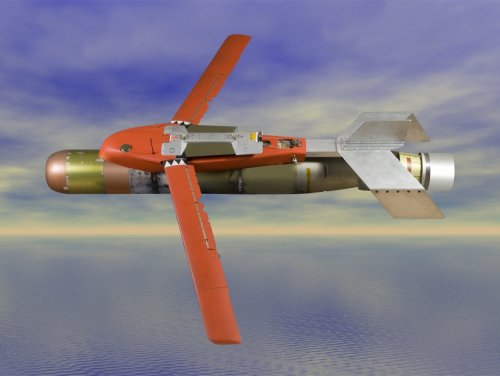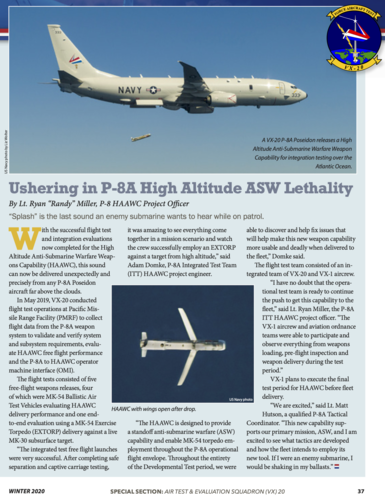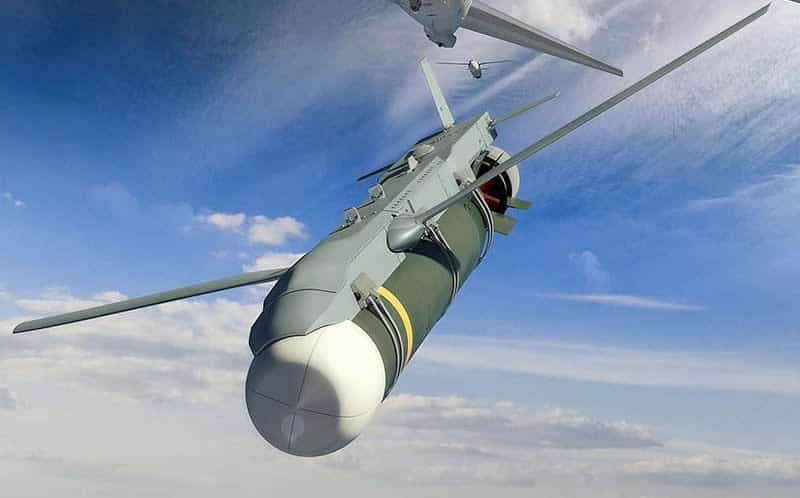"Boeing to make flying torpedoes able to attack enemy submarines from 30,000 feet"
April 4, 2013
By John Keller
Editor
Source:
http://www.militaryaerospace.com/articles/2013/04/Boeing-flying-torpedo.html
April 4, 2013
By John Keller
Editor
Source:
http://www.militaryaerospace.com/articles/2013/04/Boeing-flying-torpedo.html
WASHINGTON, 4 April 2013. Airborne weapons experts at the Boeing Co. got the go-ahead Wednesday to start building add-on kits for the U.S. Navy Mark 54 lightweight torpedo that will enable the weapon to glide through the air from altitudes as high as 30,000 feet and enable the Boeing P-8A Poseidon maritime patrol jet to attack enemy submarines from long ranges.
The Naval Sea Systems Command in Washington announced a $19.2 million contract Wednesday to the Boeing Co. Defense, Space & Security segment in St. Charles, Mo., to design and build the High Altitude Anti-Submarine Warfare Weapon Capability (HAAWC) Air Launch Accessory (ALA).
The HAAWC ALA turns the Raytheon Mark 54 torpedo into a glide weapon that the P-8A aircraft can release from high altitudes. As the flying torpedo reaches the water, it jettisons wings and other air-control surfaces and takes on its original role as a smart torpedo that detect, track, and attack enemy submarines autonomously.
The Mark 54 always has been able to be launched from aircraft, but before the HAAWC add-on kit air crews had to release the torpedo from altitudes no higher than about 100 feet.
The HAAWC will enable the P-8A aircraft -- a Boeing 737 passenger jetliner modified for maritime patrol -- to maintain optimum surveillance altitudes without wasting the time and fuel necessary to drop to low altitudes to attack targets and then climb back to high patrol altitudes.
Attacking from high altitudes also enables the P-8A to reduce the time between target acquisition and attack, as well as launch anti-submarine weapons outside the ranges of shore-based anti-aircraft defenses.
When launched from 30,000 feet the HAAWC-equipped Mark 54 torpedo will glide for seven to 10 minutes before entering the water.
While in flight the HAAWC will be completely self-contained. The HAAWC adaptor kit includes a flight control computer, a GPS-based navigation system, and power sources. When near the water the system sheds its wings and activates a parachute that lowers the torpedo to the water to begin its run toward the target.
HAAWC program requirements require Boeing to build an add-on kit that requires little or no modifications to the Mark 54 torpedo or to the P-8A Poseidon maritime patrol aircraft. Boeing's HAAWC contract includes options that could bring the value of the program to as much as $47 million.
Coincidentally, Boeing officials announced this week that they have handed over the seventh production P-8A Poseidon to the Navy on schedule March 29, marking the first delivery from the second low-rate initial production contract awarded in November 2011. The P-8 is scheduled to replace the ageing Lockheed Martin P-3 Orion four-engine turboprop maritime patrol plane.
The Mk 54 is an all-digital lightweight torpedo that has advanced software algorithms from the larger submarine-launched Mark 48 torpedo.
Boeing engineers reportedly will fit the Mark 54 torpedo with the wings designed for a Standoff Land-Attack Missile-Expanded Response cruise missile to enable to torpedo to glide to the ocean's surface. The HAAWC tail assembly is to include the guidance kit designed for the Joint Direct-Attack Munition (JDAM), which contains a GPS navigation system.
Boeing also could fit the HAAWC with a data link to transmit target position updates while in flight. Boeing will do the work on this contract in St. Charles, Mo., and should be finished by April 2016.
For more information contact Boeing Defense, Space & Security online at www.boeing.com/boeing/bds, or Naval Sea Systems Command at www.navsea.navy.mil.




